Resurs-DK1 (Resurs-High Resolution 1)
EO
ROSKOSMOS
Mission complete
High resolution optical imagers
Quick facts
Overview
| Mission type | EO |
| Agency | ROSKOSMOS, ROSHYDROMET |
| Mission status | Mission complete |
| Launch date | 15 Jun 2006 |
| End of life date | 01 Mar 2016 |
| Measurement domain | Land, Gravity and Magnetic Fields |
| Measurement category | Multi-purpose imagery (land), Albedo and reflectance, Gravity, Magnetic and Geodynamic measurements, Landscape topography |
| Measurement detailed | Land surface imagery, Fire fractional cover, Earth surface albedo, Magnetic field (vector), Land surface topography |
| Instruments | Arina, Pamela, Geoton-L1 (1) |
| Instrument type | High resolution optical imagers, Space environment |
| CEOS EO Handbook | See Resurs-DK1 (Resurs-High Resolution 1) summary |
Resurs-DK1 (Resurs-High Resolution 1)
Overview Spacecraft Mission Status Launch Sensor Complement Ground Segment References
Resurs-DK1 is Russia's first civil EO (Earth Observation) imaging satellite capable of transmitting high-resolution imagery (1 m) to the ground stations as it passes overhead. The spacecraft was designed and built by TsSKB Progress (State Research & Production Space Rocket Center) of Samara (the Samara Space Center location is on the Volga River, about 1000 km southeast of Moscow). Roskosmos is funding the project (owner and operator of the spacecraft), the commercial data distributor is Sovzond JSC of Moscow. The spacecraft is operated by Russia's Science Center for Remote Sensing of Earth, NTs OMZ. 1)
The satellite is designed for multispectral and spectrozonal mapping of the Earth's surface in the visible and near IR bands (high terrain resolution and improved geometry and photometry performance, augmented by real-time downlink data transmission). Its data will enable update and improvement of the existing geographic digital maps, offer an opportunity to enter the global market, to conduct surveys, to provide environmental monitoring, and to acquire real-time information on natural disasters or emergencies. Apart from the supply of satellite imagery to civil government authorities, the Resurs-DK1 products are to be marketed on a commercial basis. 2)
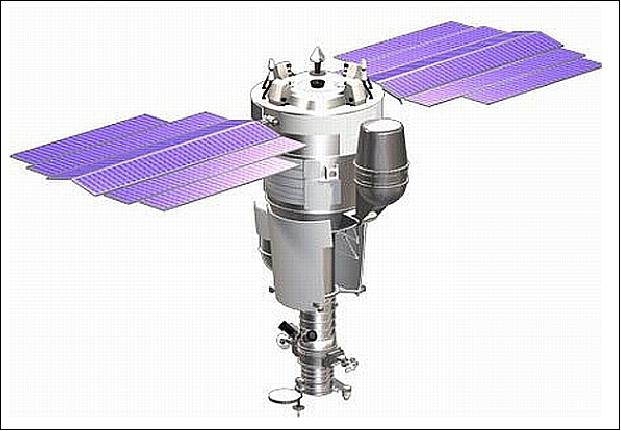
Spacecraft
The Resurs-DK1 spacecraft was designed and built by the Russian space company TsSKB Progress in Samara, Russia. The Resurs-DK spacecraft series is of military reconnaissance heritage flown in particular during the 1980-90 era. The spacecraft is three-axis stabilized. The axis orientation accuracy is 0.2 arcmin, the angular velocity stabilization accuracy is 0.005o/s. The S/C design is modular, it includes the assembly compartment with the power package module and two photovoltaic solar arrays mounted on the compartment's outer surface, the instrumentation bay and the purpose equipment bay. The design life is three years with a goal of 5 years. 3) 4) 5)
The spacecraft has a launch mass of about 6570 kg, its height is 7.4 m, the solar array span is about 14 m (total solar array size = 36 m2). The payload mass is 1200 kg. The Resurs-DK1 spacecraft provides a body-pointing capability of ± 30o into the cross-track direction.
The RF communications for the payload data are in X-band at 8.2-8.4 GHz (downlink data rate of up to 300 Mbit/s). An onboard data storage capacity of 768 Gbit is provided.
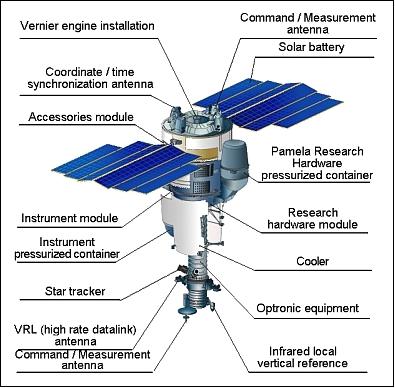
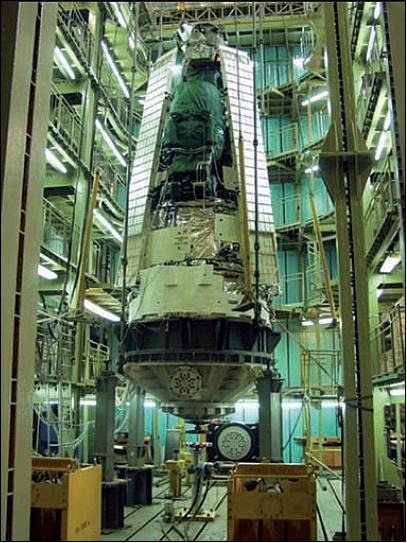
Launch
A launch of Resurs-DK1 took place on June 15, 2006 on a Soyuz-FG launch vehicle from the Baikonur Cosmodrome, Kazakhstan.
Orbit: Elliptical semi-polar orbit, altitude of 360-610 km, inclination = 70.4°, revisit time of 6 days.
Note: On Sept. 10, 2010, the orbit of Resurs-DK1 was raised to a near circular orbit of 567 km x 574 km with an inclination of 69.9°.
Mission Status
• May 15, 2015: The Resurs-DK1 spacecraft and its payload are operational in 2015. According to PAMELA project, the spacecraft is 3257 days on orbit. PAMELA results are available in a number of publications, providing new, precise information on the composition and energy spectrum of cosmic rays. 6)
- The nature of particle acceleration at the Sun, whether through flare reconnection processes or through shocks driven by coronal mass ejections, is still under scrutiny despite decades of research. The measured properties of SEPs (Solar Energetic Particles) have long been modeled in different particle-acceleration scenarios. The challenge has been to disentangle the effects of transport from those of acceleration. The PAMELA (Payload for Antimatter Matter Exploration and Light-nuclei Astrophysics) instrument enables unique observations of SEPs including the composition and angular distribution of the particles about the magnetic field, i.e., pitch angle distribution, over a broad energy range (>80 MeV)—bridging a critical gap between space-based and ground-based measurements. High-energy SEP data from PAMELA are presented, acquired during the 2012 May 17 SEP event. These data exhibit differential anisotropies and thus transport features over the instrument rigidity range. SEP protons exhibit two distinct pitch angle distributions: a low-energy population that extends to 90° and a population that is beamed at high energies (>1 GeV), consistent with neutron monitor measurements. To explain a low-energy SEP population that exhibits significant scattering or redistribution accompanied by a high-energy population that reaches the Earth relatively unaffected by dispersive transport effects, we postulate that the scattering or redistribution takes place locally. We believe that these are the first comprehensive measurements of the effects of solar energetic particle transport in the Earth's magnetosheath. 7)
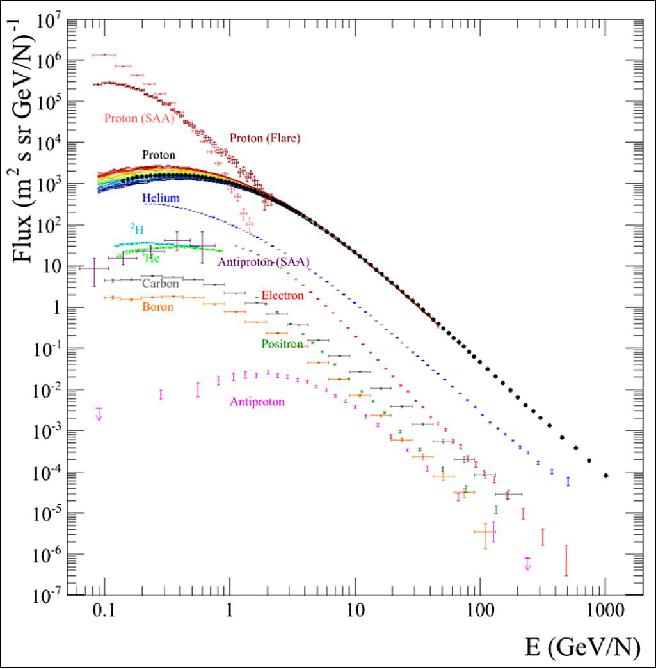
• On June 15, 2013, the Resurs-DK1 spacecraft and its payload are on orbit for 7 years (design life of 3 years), operating nominally. The operational life of the mission has been extended. 9)
- During this time, PAMELA registered > 3.4 x 109 triggers; and ~ 40 TB of PAMELA data were downlinked.
• In the summer of 2011, the PAMELA research team (collaboration) is reporting the discovery of an antiproton radiation belt around the Earth. The trapped antiproton energy spectrum in the SAA (South Atlantic Anomaly) region has been measured by the PAMELA experiment for the kinetic energy range 60-750 MeV. A measurement of the atmospheric sub-cutoff antiproton spectrum outside the radiation belts is also reported. PAMELA data show that the magnetospheric antiproton flux in the SAA exceeds the cosmic-ray antiproton flux by three orders of magnitude at the present solar minimum, and exceeds the sub-cutoff antiproton flux outside radiation belts by four orders of magnitude, constituting the most abundant source of antiprotons near the Earth. 10) 11)
• The Resurs-DK1 spacecraft is operating nominally in 2011.
• On Sept. 10, 2010, the perigee of the Resurs-DK1 spacecraft was raised from an initial 355 km x 573 km (elliptical orbit) to a near circular orbit of 567 km x 574 km. This was done to extend the life span of the mission. 12)
• In the fall of 2010, the PAMELA instrument is working nominally in orbit (after ~1500 days since launch). So far, ~ 20 TB of PAMELA data were downlinked and > 3 x 109 triggers were registered. 13)
- The instrument provides good electron and positron separation with rejection of protons about 105
- The electron /positron spectra, obtained by different methods, are in good agreement
- Preliminary estimations show that the positron spectrum appears to be harder than the prediction of the "conventional " diffusive model.
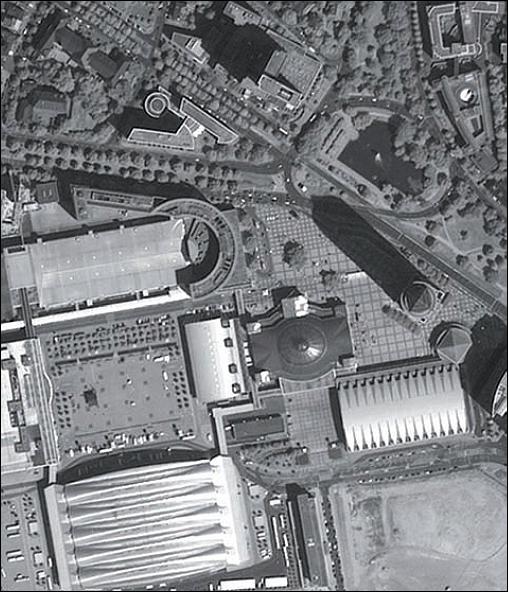
• The Resurs-DK1 spacecraft is operating nominally as of 2009.
>• As of May 7, 2009, PAMELA is on for 1058 days - providing 8023 files in 3728 downlinks with a data volume of 13.5 TB. The PAMELA experiment operations is scheduled to last until the end of 2011. 15)
• The Resurs-DK1 spacecraft is operating nominally in the fall of 2008. 16)
• Mission operations started on Sept. 21, 2006 after 3 months of spacecraft commissioning. The spacecraft was declared operational. 17)
• For PAMELA the in-orbit instrument test was completed on July 11, 2006. Since then, the instrument is in continuous data taking mode. PAMELA is measuring antiparticles with an unprecedented statistical precision. PAMELA was switched on for the first time on June 21, 2006. 18)
• GeoDesign International, based in Lorena, Sao Paulo, Brazil, has signed a distributor contract with Sovinformsputnik of Moscow, Russia, to distribute high resolution imagery data from the Russian satellite Resurs-DK1 in Brazil.
• NTs OMZ received the first images from the satellite on June 23, 2006 (Ref. 12).
Sensor Complement: (Geoton-1, PAMELA, ARINA)
Geoton-1 Imager
Geoton-1 (also referred to as Geoton-L1) is an optoelectronic pushbroom imaging instrument. The overall objective is to obtain high-resolution imagery of the Earth's surface for commercial and research applications. The instrument provides panchromatic and multispectral imagery in a total of 4 bands in the VNIR spectral range. A survey observation mode provides image scenes of up to 2100 km (along-track). The instrument can be tilted in the cross-track direction for an improved FOR (Field of Regard), this is being done by spacecraft body-pointing (± 30o). 19) 20)
The optical subsystem of the Geoton-1 imager has a focal length of 400 cm and an aperture diameter of 50 cm. The FPA (Focal Plane Assembly) features 4 TDI (Time Delay and Integration) detector arrays, one panchromatic and three multispectral. Each detector array is composed of 36 "Kruiz" photosensitive CCD chips (also referred to as PhCCD). Effective length of the single array is about 36000 pixels. The Kruiz CCD is a 1024 pixel x 128 line, high speed TDI sensor. The active imaging area is organized as 1024 vertical columns and 128 horizontal TDI rows. The pixel size is 9 µm x 9 µm.
• The number of TDI stages electronically selectable is:: 128, 64, 32, 16, 8
• There are two readout shift registers and two output amplifiers allowing a twice faster readout
• Dynamic range: 2500
• Maximum quantum efficiency: 0.33 (at 0.72 µm).
The instrument has a mass of 310 kg; it was designed jointly by NPO Opteks and CNII Electron and manufactured by CNII Electron, Russia.
Parameter | Value | Parameter | Value |
PAN band | 0.58 - 0.8 µm | Spatial resolution (PAN) | 1 m GSD (Ground Sample Distance) |
MS bands (µm) | 0.50 - 0.60 | Spatial resolution (MS) | 2.5-3.5 m |
Downlink data rates | 75, 150 or 300 Mbit/s | Storage capacity | 768 Gbit |
Swath width | 28.3 km at nadir (from a 360 km orbit) | FOR (Field of Regard) | 448 km |
Data quantization | 10 bit | Position accuracy | 100 m |
Applications of Geoton-1 data: Sea surface status, ice situation, meteorological conditions in Earth polar regions, information for Earth natural resources study, data on ecology and emergency, as well as to support digital data exchange between ground users.
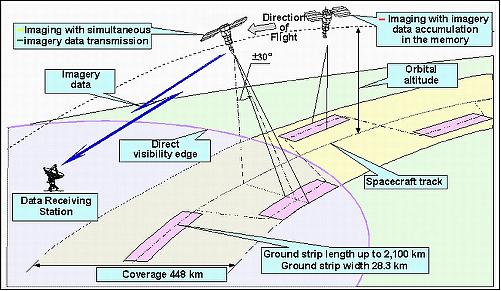
PAMELA (Payload for AntiMatter Exploration and Light-nuclei Astrophysics)
The objective of the PAMELA magnet spectrometer (secondary payload) is to observe the fluxes of charged particles and non-stationary phenomena in cosmic ray research. PAMELA is a Russian/Italian science instrument for high-energy particle research (understanding of the antimatter component of cosmic radiation), carried out by the WiZard collaboration (heritage of the MIR Station and balloon-borne experiments). There are now 14 institutions involved, referred to as the WiZard collaboration. INFN (Italian National Institute of Nuclear Physics) groups in Bari, Florence, Frascati, Naples, Rome and Trieste, and groups from CNR, Florence and the Moscow Engineering and Physics Institute form the core. They are joined by groups from The Royal Institute of Technology (KTH) in Sweden, Siegen University in Germany, Russian groups from the Lebedev Institute, Moscow, and the Ioffe Institute, St Petersburg, as well as American groups from New Mexico State University, and NASA's Goddard Spaceflight Center. 21) 22) 23) 24) 25) 26) 27)
The PAMELA experiment represents one of the most important steps of an extensive research program dedicated to the study of the nuclear and isotopic components of cosmic rays, and to antimatter detection in space.
Cosmic-ray particle | Energy range |
Antiprotons | 80 MeV - 190 GeV |
Positrons | 50 MeV - 270 GeV |
Electrons | 50 MeV - 400 GeV |
Protons | 80 MeV - 700 GeV |
Electrons+positrons | up to 2 TeV |
Light nuclei (up to Z=6) | 100 MeV/n - 700 GeV/n |
Antinuclei | of the order of 10-7 |
PAMELA consists of a time-of-flight / trigger system, transition radiation detector, a magnetic spectrometer with silicon tracking, an anticoincidence system, a silicon-tungsten imaging electromagnetic calorimeter, a shower-tail catcher and a neutron counter. - The instrument is built around a 0.48 T permanent magnet spectrometer tracker equipped with double-sided silicon detectors; they are being used to measure the sign, absolute value of charge and momentum of particles. The tracker is surrounded by a scintillator veto shield (anticounters) rejecting particles that do not pass cleanly through the acceptance of the tracker.
The instrument is mounted on the S/C to provide a clear space view. The primary objective of PAMELA is to measure the energy spectrum of antiprotons and positrons in the cosmic radiation. Per year, at least 105 positrons and 104 antiprotons are expected. All present measurements originate from balloon-borne experiments operating at altitudes around 40 km for approximately 24 hours. There is still a residual amount of the Earth's atmosphere above the detecting apparatus at this altitude with which cosmic rays can interact, complicating unambiguous particle identification. A spaceborne experiment benefits from a lack of atmospheric overburden and a longer data-taking times (3 years for PAMELA).
The PAMELA instrument has a size of 123 cm x 70 cm x 70 cam, it has a mass of 470 kg with an average power consumption of 360 W.
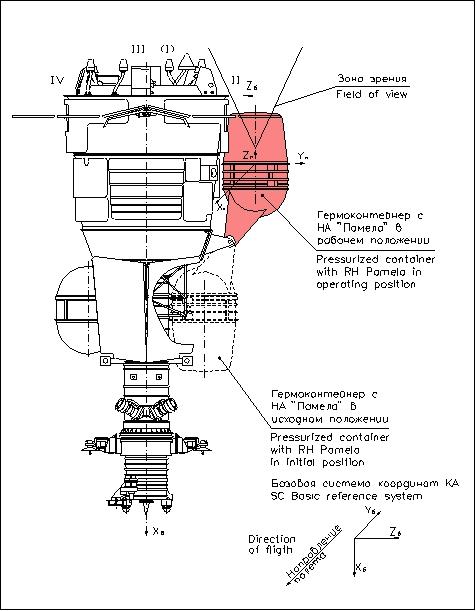
The PAMELA data sets will exceed what is available today by several orders of magnitude and will allow significant comparisons between competing models of antimatter production in our galaxy. Distortions to the energy spectra are very interesting because of possible contributions from exotic sources, such as the annihilation of supersymmetric neutral particles - candidates for the dark matter in the universe. Sensitivity to the low energy part of the spectrum is a unique capability of PAMELA and arises because the semi-polar Resurs orbit overcomes the Earth's geomagnetic cut-off.
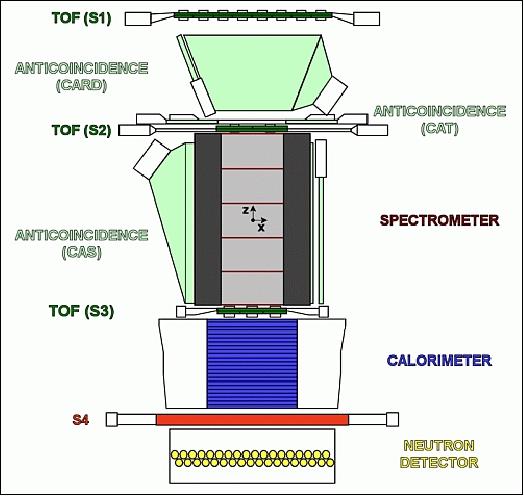
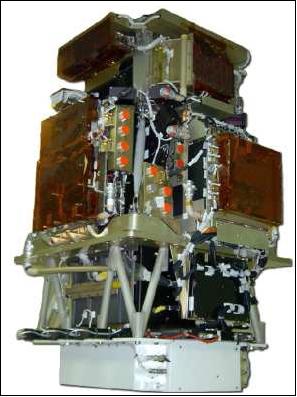
The basic instrument design consists of the following elements: 28)
• A magnetic spectrometer (made of a permanent magnet and a tracking device), to track charged particles and to determine, through the track curvature, the sign of their charge and their rigidity up to very high momenta
• An "imaging" electromagnetic calorimeter, an instrument capable not only to measure the energy of those particles interacting in its sensitive volume, but also to image the shape of these interactions. The latter feature is of great value for particle identification, since events originated from annihilation of low-energy antiprotons (and, eventually, antinuclei) have a typical pattern
• A precise ToF (Time-of-Flight) counter to measure the velocity of particles. TOF is composed of several layers of plastic scintillators read out by PMTs (Photo-Multiplier Tubes. The ToF must fulfil the tasks of:
- Providing of a fast signal for triggering data acquisition in the whole instrument
- Measuring the flight time of particles crossing its planes; this information, integrated with the measurement of the trajectory through the instrument, gives their velocity b can be derived. This feature enable also the rejection of albedo particles
- Determining the absolute value of charge Z of incident particles through multiple measurements of their energy loss dE/dx in the scintillator counters.
• An additional instrument to measure the velocity of particles in the energy range not covered by the ToF, thus helping the calorimeter in particle identification.
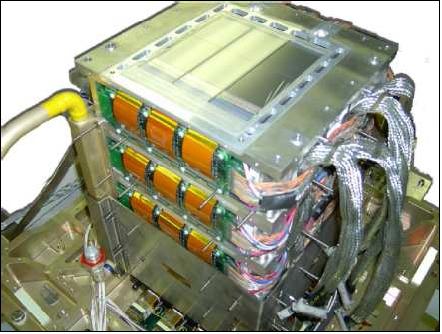
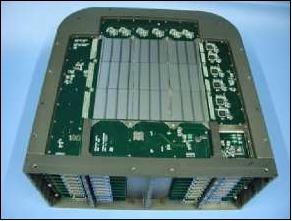
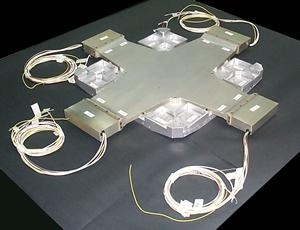
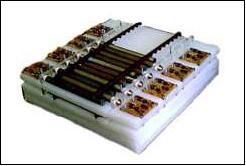
The neutron detector of the Lebedev Physical Institute in Moscow is placed just under the S4 counter with the aim to increase the electromagnetic and hadronic discrimination capability of the PAMELA instrument and to expand the energy range of the detected primary protons and electrons up to 1011-1013 eV. It consists of 36 3He counters, enveloped by a polyethylene moderator, able to detect thermal neutrons with an efficiency of 10%, including the thermalization efficiency of the neutrons produced in the calorimeter.
The size of the neutron detector is 60 cm x 55 cm x 15 cm, the total weight is 30 kg, power consumption is 10 W. The signal from the neutron detector is used for the selection of electrons over the background of hadrons.
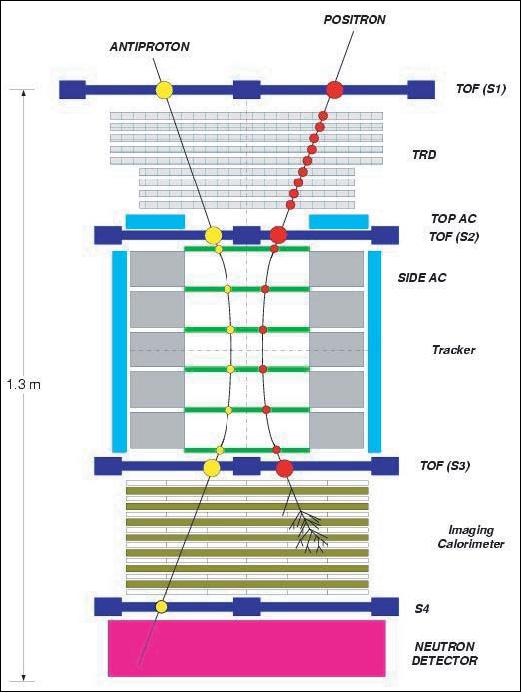
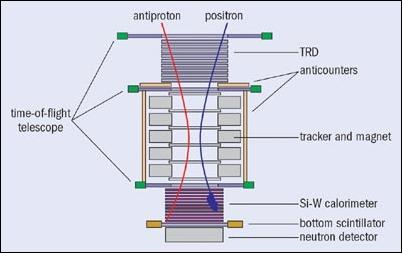
PAMELA is built around a 0.4 T permanent magnet spectrometer (tracker) equipped with double-sided silicon detectors used to measure the sign, absolute value of charge and momentum of particles. The tracker is surrounded by a scintillator veto shield (anticounters) which is used to reject particles which do not pass cleanly through the acceptance of the tracker. Above the tracker is a transition radiation detector based around proportional straw tubes and carbon fiber radiators. This allows electron-hadron separation through threshold velocity measurements. Mounted below the tracker is an imaging silicon-tungsten calorimeter. This measures the energies of incident electrons and allows topological discrimination between electromagnetic and hadronic showers (or non-interacting particles). 29) 30)
A scintillator telescope system provides the primary experimental trigger and time-of-flight particle identification.
An additional scintillator (bottom scintillator) is mounted beneath the calorimeter to provide an additional trigger for high energy electrons (>100 GeV).
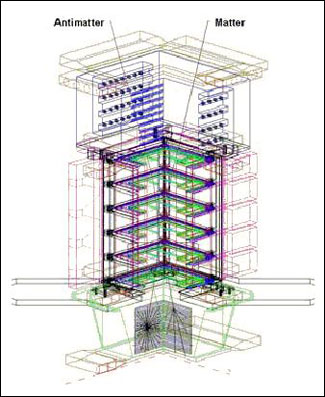
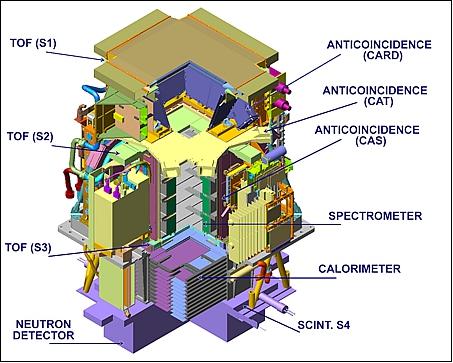
PAMELA data acquisition (DAQ) and trigger system (Figure 18): The PSCU (PAMELA Storage and Control Unit) handles all slow controls, communication with the satellite, data acquisition, storage and downlink tasks.
The PSCU contains 4 subsystems:
• A processor module is built around a CPU based on a ERC-32 architecture (SPARC v7 implementation) running the RTEMS real time operating system at 24 MHz. The CPU is custom built by Laben and is fully space qualified. Communication with the Resurs-DK1 satellite is realized via a standard MIL-STD-1553B data bus
• Two redundant 2 GByte mass memory modules. The modules include latchup detection, allowing operation to be transparently switched to the safe module when a latchup is detected
• A PIF (PAMELA Interface Board) that performs three main tasks: communication with the IDAQ (Intermediate DAQ) system through a DMA (Dynamic Memory Access) controller, handling the interface with the mass memory, and providing the interface with the VRL (Very high-speed Radio Link) module of the satellite
• A TMTC (Telemetry and Control) board that handles the housekeeping operations of PAMELA, such as alarm, temperature and voltage monitoring (once per second). Such monitoring is performed both directly (ADC inputs and contact closure telemetries) and through a dedicated housekeeping board that communicates through serial data links with the sub-detector read-out boards, with the IDAQ board and with the power supply control boards.
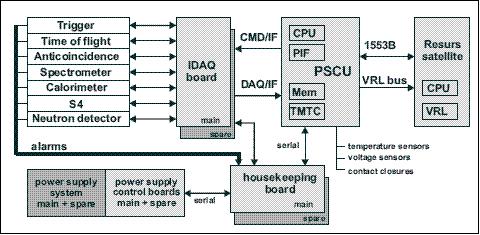
Data acquisition from the sub-detectors is managed by the IDAQ system at a rate of 2 MB/s. Upon receipt of a trigger, the PSCU initiates the IDAQ procedure to read out data from the sub-detectors in sequence. The resulting data are stored in the PSCU mass memory. Several times a day, the data are transferred to the satellite onboard memory via the 12 MB/s VRL bus where it is stored prior to downlinking to Earth. Approximately 15 GByte are transferred to the ground per day during 2-3 downlink sessions.
The PSCU automatically handles the flow of PAMELA physics tasks and continuously checks for proper operation of the apparatus.
ARINA Instrument Assembly
ARINA is a Russian science instrument, a spectrometer and particle detector for the observation of solar-magnetosphere variations of charged particle fluxes. The objective of the ARINA mission is an attempt to get a better insight into electromagnetic field fluctuations, the precursors of earthquakes. ARINA permits to identify and to determine the energy of electrons in the energy range 3-30 MeV, and protons in energy range 30-100 MeV. The main characteristics of spectrometer are: instrument mass = 9 kg, energy resolution of 15 %, geometrical factor of 10 sm2 sr. The data of ARINA are being used to study physical phenomena related to earthquakes. 31)
Ground Segment
The ground segment of the Resurs DK1 system is located at the Research Center for Earth Operative Monitoring (NTs OMZ) in Moscow, Russia. This is part of the Roskosmos ground segment designed for acquiring, recording, processing and distributing data from remote sensing systems in space.
The ground segment includes:
• Ground control complex, including commanding and measuring facilities and mission control center
• Ground complex for receiving, processing and distribution of information, including ground receiving stations, complex of interaction with the customers and information processing
• Regional stationary and mobile ground receiving stations.
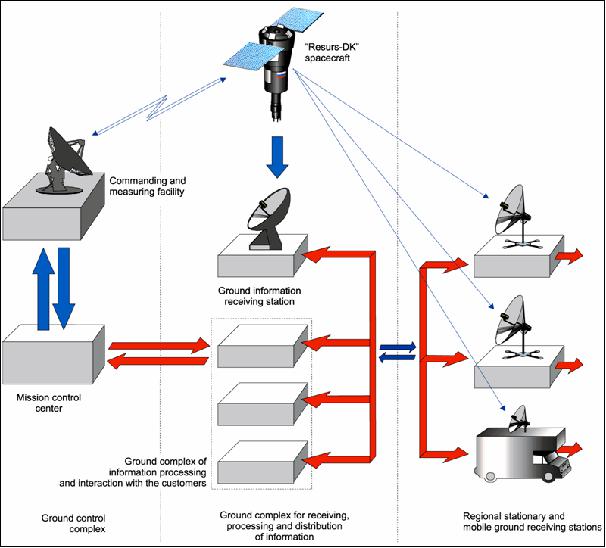
References
1) A. Fournier-Sicre, T. Suslova, A. Krasnov, "Resurs-DK1 - Visual and IR-band imaging at 1m resolution," ESA "News from Moscow," Special Issue No 9, July 7, 2003, pp. 11-14
2) V. Asmus, "Russian Environmental Satellites: Current Status and Development Perspectives," Submitted to CEOS PLenary Meeting, Colorado Springs, Nov. 19-20, 2003,
3) G. P. Anshakov, V. K. Skirmunt, "The Russian project of "resurs-DK 1 "space complex development. Status, prospects, new opportunities for the consumers of space snapshots," Acta Astronautica, Vol. 47, Issues 2-9, July-November 2000, pp. 347-353
4) "Perspectives of the Russian Earth remote sensing space system," URL: http://www.senado.gob.mx/comisiones/LX/cyt/content/presentaciones/docs/ROSCOSMOS2.pdf
5) Gordon Petrie, "An Alternative Source of Very High-resolution Imagery - The Resurs-DK1 Satellite," GEO Informatics, April/May 2010, pp.30-34, URL: http://web2.ges.gla.ac.uk/~gpetrie/Petrie_Resurs-DK1_GEO_April-May_2010.pdf
6) "The Space Mission PAMELA," May 15, 2015, URL: http://pamela.roma2.infn.it/index.php
7) O. Adriani, G. C. Barbarino, G. A. Bazilevskaya, R. Bellotti, M. Boezio, E. A. Bogomolov, M. Bongi, V. Bonvicini, S. Bottai, U. Bravar, A. Bruno, F. Cafagna, D. Campana, R. Carbone, P. Carlson, M. Casolino, G. Castellini, E. R. Christian, C. De Donato, G. A. de Nolfo, C. De Santis, N. De Simone, V. Di Felice, V. Formato, A. M. Galper, A. V. Karelin, S. V. Koldashov, S. Koldobskiy, S. Y. Krutkov, A. N. Kvashnin, M. Lee, A. Leonov, V. Malakhov, L. Marcelli, M. Martucci, A. G. Mayorov, W. Menn, M. Mergé, V. V. Mikhailov, E. Mocchiutti, A. Monaco, N. Mori, R. Munini, G. Osteria, F. Palma, B. Panico, P. Papini, M. Pearce, P. Picozza, M. Ricci, S. B. Ricciarini, J. M. Ryan, R. Sarkar, V. Scotti, M. Simon, R. Sparvoli, P. Spillantini, S. Stochaj, Y. I. Stozhkov, N. Thakur, A. Vacchi, E. Vannuccini, G. I. Vasilyev, S. A. Voronov, Y. T. Yurkin, G. Zampa, N. Zampa, "Pamela's Measurements of Magnetospheric Effects On High Energy Solar Particles," Astrophysical Journal Letters, Vol. 801, No 1, Feb. 24, 2015, URL of Abstract: http://iopscience.iop.org/2041-8205/801/1/L3/article
8) URL: http://pamela.roma2.infn.it/index.php?option=com_content&task=view&id=1942&Itemid=290
9) Emiliano Mocchiutti, "Cosmic-Ray Positron Energy Spectrum Measured with the PAMELA Experiment," 33rd ICRC (InternationalCosmic Rays Conference), Rio de Janeiro, Brazil, July 2-9, 2013, URL: http://tinyurl.com/mblvh26
10) O. Adriani, G. C. Barbarino, G. A. Bazilevskaya, R. Bellotti, M. Boezio, E. A. Bogomolov, M. Bongi, V. Bonvicini, S. Borisov, S. Bottai, A. Bruno, F. Cafagna, D. Campana, R. Carbone4, P. Carlson, M. Casolino, G. Castellini, L. Consiglio, M. P. De Pascale, C. De Santis, N. De Simone, V. Di Felice, A. M. Galper, W. Gillard, L. Grishantseva, G. Jerse, A. V. Karelin, M. D. Kheymits, S. V. Koldashov, S. Y. Krutkov, A. N. Kvashnin, A. Leonov, V. Malakhov, L. Marcelli, A. G. Mayorov, W. Menn, V. V. Mikhailov, E. Mocchiutti, A. Monaco, N. Mori, N. Nikonov, G. Osteria, F. Palma, P. Papini, M. Pearce, P. Picozza, C. Pizzolotto, M. Ricci, S. B. Ricciarini, L. Rossetto, R. Sarkar, M. Simon, R. Sparvoli, P. Spillantini, Y. I. Stozhkov, A. Vacchi, E. Vannuccini, G. Vasilyev, S. A. Voronov, Y. T. Yurkin, J. Wu, G. Zampa, N. Zampa, V. G. Zverev, "The Discovery of Geomagnetically Trapped Cosmic-Ray Antiprotons," The Astrophysical Journal Letters, Vol. 737, No 2, Aug. 20, 2011, doi: 10.1088/2041-8205/737/2/L29
11) "Ring Of Anti-Protons Found Encircling Earth," Universe Today, Aiug. 16, 2011, URL: http://www.universetoday.com/88230/ring-of-anti-protons-found-encircling-earth/
12) http://www.russianspaceweb.com/resurs_dk.html
13) V. Mikhailov, L. A. Grishantseva, M. Boezio, E. Mocchuiutti, P. Papini, on behalf of the PAMELA collaboration, "Cosmic Ray electron and positron energy spectra measured by PAMELA," 22nd ECRS (European Cosmic Ray Symposium), Turku, Finland, Aug. 3-6, 2010, URL: http://ecrs2010.utu.fi/done/presentations/EDU1/1A_PA1_Tuesday/2_Mikhailov.pdf
14) "Resurs-DK satellite imagery," Sovzond, URL: http://www.sovzond.ru/en/satellites/russia/1426.html
15) A. M. Galper, "The PAMELA Mission," PAMELA Workshop, Rome Italy, May 11-12, 2009, URL: http://pamela.roma2.infn.it/workshop09/slides_WS2009/Galper.ppt
16) Nov. 18, 2008, NzsOMZ, URL: http://eng.ntsomz.ru/ks_dzz/satellites/resurs_dk1
17) http://www.russianspaceweb.com/resurs_dk.html
18) M. Casolino, P. Picozza, on behalf of the PAMELA collaboration, "Launch and commissioning of the PAMELA experiment on board the Resurs-DK1 satellite," Advances in Space Research, Vol. 41, 2008, pp. 2064–2070, URL: http://pamela.roma2.infn.it/index.php?option=com_docman&task=doc_view&gid=233&Itemid=251
19) M. Elderdova, "Applications of high resolution satellite imagery acquired from Russian satellite Resurs-DK1," 4th International Conference on 'Recent Problems in Geodesy and Related Fields with International Importance,' Sofia Bulgaria, Feb. 28 - March 2, 2007
20) G. I. Vishnevsky, M. G. Vidrevitch, V. G. Kossov, O: P. Kourova, M. V. Chetvergov, "Unpacked TDI PhCCD designed for large format optoelectronic systems for the Earth remote sensing," Proceedings of SPIE, 'Smart Imagers and Their Application,' Alexander L. Stempkovsky, Victor A. Shilin, Editors, 594409, Vol. 5944, Dec. 6, 2006
21) P. Picozza, A. M. Galper, G. Castellini, O. Adriani, F. Altamura, M. Ambriola, G. C. Barbarino, A. Basili, G. A. Bazilevskaja, R. Bencardino, M. Boezio, E. A. Bogomolov, L. Bonechi, M. Bongi, L. Bongiorno, V. Bonvicini, F. Cafagna, D. Campana, P. Carlson, M. Casolino, C. De Marzo, M.P. De Pascale, G. De Rosa , D. Fedele, P. Hofverberg, S. V. Koldashov, S. Yu. Krutkov, A. N. Kvashnin, J. Lund, J. Lundquist, O. Maksumov, V. Malvezzi, L. Marcelli, W. Menn, V. V. Mikhailov, M. Minori, S. Misin, E. Mocchiutti, A. Morselli, N.N. Nikonov, S. Orsi, G. Osteria, P. Papini, M. Pearce, M. Ricci, S. B. Ricciarini, M. F. Runtso, S. Russo, M. Simon, R. Sparvoli, P. Spillantini, Yu. I. Stozhkov, E. Taddei, A. Vacchi, E. Vannuccini, S. A. Voronov, Y. T. Yurkin, G. Zampa, N. Zampa , V. G. Zverev, "PAMELA - A Payload for Antimatter Matter Exploration and Light-nuclei Astrophysics," arXiv: astro-ph/0608697 v1, 31 Aug. 2006, URL: http://www.citebase.org/fulltext?format=application%2Fpdf&identifier=oai%3AarXiv.org%3Aastro-ph%2F0608697
22) PAMELA collaboration homepage: http://wizard.roma2.infn.it/pamela/
23) R. Sparvoli, V. Malvezzi, L. Grishantseva, D. Campana, G. De Rosa, G. Osteria, W. Menn, L. Bonechi, M. Bongi, S. Ricciarini, E. Vannuccini, "Capability of the PAMELA instrument to identify light-nuclei: results from a beam test calibration," ECRS 2006 ()European Cosmic Ray Symposium), Lisbon, Portugal, Sept. 5-8, 2006, URL: http://people.roma2.infn.it/~aldo/Pamela_sparvoli_ECRS2006_lisbon.pdf
24) Silvio Orsi, "The Anticoincidence Shield of the PAMELA Satellite Experiment," Licentiate Thesis, KTH, Stockholm, Sweden, June 2004, URL: http://www.particle.kth.se/~silvio/files/lic-silvio.pdf
25) F. S. Cafagna, "First results of the PAMELA Space Experiment," 2009, URL: http://moriond.in2p3.fr/J09/transparents/cafagna.pdf
26) Mark Pearce, "PAMELA Payload for Antimatter /Matter Exploration and Light-nuclei Astrophysics," 2007, URL: http://www-conf.slac.stanford.edu/ssi/2007/talks/pearce_080707_F.pdf
27) MirkoBoezio, "Indirect Detection of Dark Matter with PAMELA," LHC and Dark Matter Workshop,January 6-10, 2009, Ann Arbor, MI, USA, URL: http://www.umich.edu/~mctp/SciPrgPgs/events/2009/LHC/talks/LHCDM_Boezio.pdf
28) http://pamela.physik.uni-siegen.de/pamela/satellite.html
29) O Adriani, "Looking for Dark Matter in Cosmic Rays with Pamela Experiment," EuroGDR 2007 (Groupement de Recherches), Nov. 12-14, 2007, Brussels, Belgium, URL: http://pamela.roma2.infn.it/index.php?option=com_docman&task=doc_download&gid=178&Itemid=251
30) M. Simon, et al., "Status of the PAMELA Experiment On-board of the Resurs-DK1 Spacecraft", Proceedings of 28th International Cosmic Ray Conference (ICRC), Tsukuba, Japan, 2003, pp. 2117-2120
31) S. Yu. Aleksandrin, A. V. Bakaldin, A. G. Batischev, M. A. Bzheumikhova, S. A. Voronov, A. M. Galper, L. A. Grishantseva, S. V. Koldashov, P. Yu. Naumov, V. Yu. Chesnokov, N. D. Sharonova, V. A. Shilov, "Observation of Solar-Magnetospheric and Geophysical Effets on the Electron and Proton Fluxes Detected by the Satellite-Borne ARINA Instrument," Bulletin of the Russian Academy of Sciences: Physics, 2009, Vol. 73, No 3, pp. 361-363, ISSN 1062-8738
The information compiled and edited in this article was provided by Herbert J. Kramer from his documentation of: "Observation of the Earth and Its Environment: Survey of Missions and Sensors" (Springer Verlag) as well as many other sources after the publication of the 4th edition in 2002. - Comments and corrections to this article are always welcome for further updates (eoportal@symbios.space).
Overview Spacecraft Mission Status Sensor Complement Ground Segment References Back to top